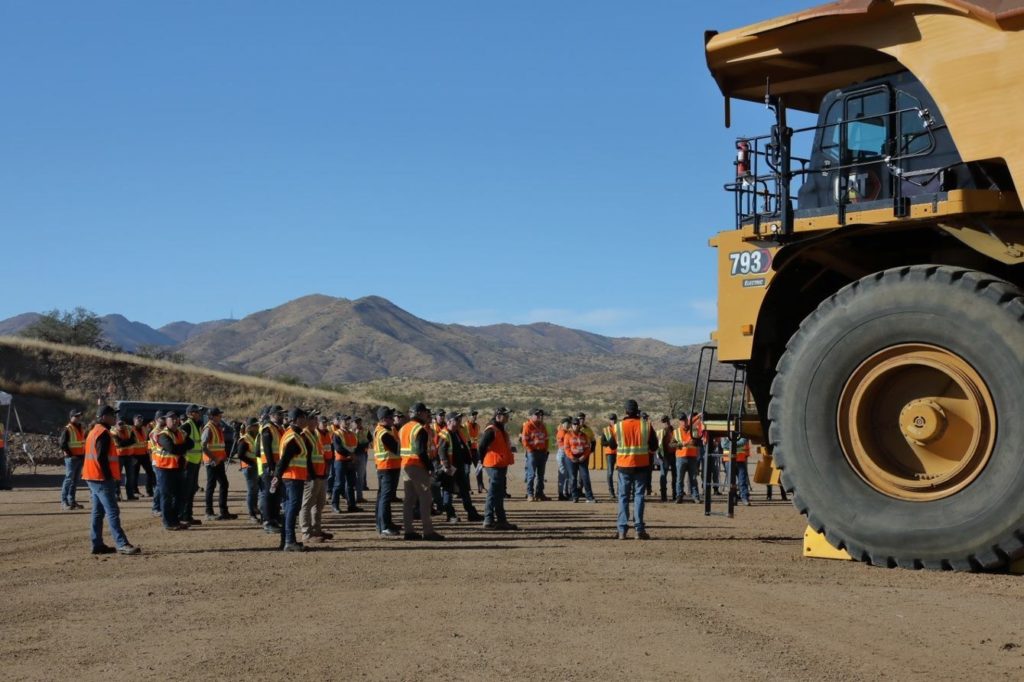Caterpillar Inc has released its 2023 Annual Report, Sustainability Report, Diversity & Inclusion Report and Lobbying Report. Starting with the full annual report and looking at Caterpillar’s overall 2023 results, the numbers are good, but don’t actually represent overall increased sales volume, rather better achieved pricing. Resource Industries’ total sales were $13.583 billion in 2023, an increase of $1.269 billion, or 10%, compared with $12.314 billion in 2022. Caterpillar: “The increase was due to favourable price realisation, partially offset by lower sales volume. Sales volume decreased as higher sales of equipment to end users were more than offset by the impact from changes in dealer inventories and lower aftermarket parts sales volume. Dealer inventory increased more during 2022 than during 2023.”
Resource Industries’ profit was $2.834 billion in 2023, an increase of $1.007 billion, or 55%, compared with $1.827 billion in 2022. Again, the increase was mainly due to favourable price realisation, “partially offset by unfavourable manufacturing costs and currency impacts. Unfavourable manufacturing costs were driven by higher materials costs, the impact of manufacturing inefficiencies and unfavourable cost absorption, partially offset by lower freight.” Cost absorption was unfavourable as inventory increased more during 2022 than during 2023. Resource Industries’ profit as a percentage of total sales was 20.9% for 2023, compared with 14.8% for 2022.
In Resource Industries, in 2024, for both mining and heavy construction and quarry and aggregates, Caterpillar anticipates lower sales volume compared to 2023, primarily due to off-highway and articulated trucks. “While we continue to see a high level of quoting activity overall, we anticipate lower order rates as customers display capital discipline. Customer product utilisation remains high, the number of parked trucks remains low, the age of the fleet remains elevated and our autonomous solutions continue to have strong customer acceptance. We expect higher services revenues, including robust rebuild activity in 2024. We continue to believe the energy transition will support increased commodity demand over time, expanding our total addressable market and providing further opportunities for long-term profitable growth.”
Moving to the 2023 Sustainability Report, Caterpillar had some impressive updates on its ongoing success with autonomy. In 2023, the team reached a milestone of 10 years of autonomous operations. Through the end of 2023, this fleet counted more than 630 large mining trucks that moved a combined 7.5 billion metric tons. Caterpillar added: “This fleet is growing every year as customers look to automation and autonomy to drive operational consistency and deliver results. In 2023, zero of our autonomy customers reported lost time injuries caused by Caterpillar’s autonomous system. Another customer publicly reported their autonomous fleet burns less fuel per ton moved due to less idle time and fewer specific near-miss events.”
Today, Caterpillar says it offers a range of remote control, semi-autonomous and fully autonomous solutions designed to meet specific customer needs at their worksites, with a portfolio of options for haul trucks, water trucks, drills, dozers, wheel loaders and underground loaders. For example, a single operator can simultaneously operate up to four semi- autonomous dozers from a remote location.
It adds: “The demand for an autonomous fleet also has expanded dramatically. When we first introduced autonomous machines a decade ago, only about 10% of mines in the world had a fleet large enough – approximately 70 trucks or more – to justify the capital investment.” It says today autonomy can make financial sense for mines with as few as 12 trucks in their fleet. “This opportunity not only translates into business growth for Caterpillar, but also offers the opportunity to impact carbon reductions and safety improvements.”
On alternative fuels, Cat also pointed out that it offers machines and engines that are capable of operating on alternative fuels, such as biodiesel, biogas, hydrogen, HVO and methanol. “All Caterpillar diesel engines, for example, can operate on 100% HVO. While fuels such as HVO and biodiesel produce GHG emissions at the tailpipe that are essentially the same as traditional fuels, lower-carbon intensity fuels may reduce lifecycle GHG emissions in the fuel value chain.”
Finally, on electrification, Caterpillar points out that deploying an electrified industrial equipment portfolio is a more complex undertaking than the electrification of a passenger vehicle. “Among the many considerations are longer battery life requirements to enable operation at a jobsite throughout the day and unique charging infrastructure challenges in remote areas where mining and infrastructure work may occur. With a portfolio that includes both transportation and energy solutions, we have a unique opportunity to solve these challenges and innovate new electrification solutions for our customers.”
Cat says it is gaining valuable experience from initial introductions of battery-powered equipment and the additional battery- powered machines and chargers under development that can help our customers achieve their climate-related objectives. “Following the demonstration of our first battery electric 793 Large Mining Truck Prototype in 2022, we continue to develop the Caterpillar Early Learner program, which focuses on accelerating the deployment and validation of the Cat battery electric trucks at participating customers’ sites. The building of Early Learner trucks is underway. Caterpillar has also successfully demonstrated our first battery electric prototype underground mining truck. This battery electric truck will complete Caterpillar’s first fully electric underground load and haul solution when paired with the commercially available R1700 XE Battery Electric Loader.”











